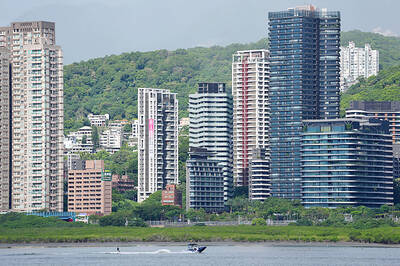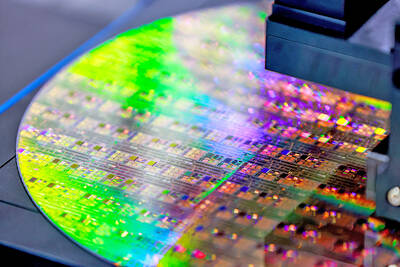Sliding prices, massive bad loans at banks and mounting government debt continue to threaten Japan's sovereign debt rating, which could be downgraded within two years, Standard and Poor's said yesterday.
At the same time, progress in tackling the nation's economic woes would support the rating at its current level and could lead to an upgrade of Japan's outlook, said S&P credit analyst Takahira Ogawa.
The rating agency affirmed Japan's AA-minus long-term rating -- the weakest of the Group of Seven rich countries -- and A1-plus short-term local currency ratings, with the outlook remaining negative.
"In the short term, it will be very difficult for Japan to deal with its pressing problems: to overcome deflation; to improve banking sector non-performing loans [NPLs]; and to stabilize fiscal deficits and the debt burden," Ogawa said in a statement.
"If deflation is not contained, banking system NPLs and government finances will deteriorate and undermine the ratings on the sovereign," he warned.
The negative outlook means S&P may downgrade Japan's sovereign rating within one or two years "if ... things go on as they are," Ogawa said later by phone from Singapore.
"But if there are good developments in economic policy, if Japan can come out of deflation [the rating] might stay," he said, adding that the outlook could also be raised.
Japan remains the world's second-largest economy with net foreign assets worth a staggering yen1.46 trillion, a strong current account surplus and a widely-traded currency, S&P noted.
Other positive factors include the nation's highly skilled workforce, world-leading manufacturing industry and high savings rate, the agency said.
But deflation, which hurts corporate profits and deters consumer spending as people wait for prices to fall further, has aggravated Japan's fiscal and financial problems since the middle of the 1990s.
Government debt -- which at around 140 percent of GDP is the highest among industrialized nations -- is expected to grow, while Japanese banks remained buried under huge bad loans.
The government has instructed banks to halve the ratio of bad loans on their accounts by March 2005 and re-evaluate other assets -- a move that prompted regional lender Resona Holdings to ask for a government bailout last month.
S&P is wary about whether the banks will return to health.
"Japan still cannot find its way out of deflation, which is exacerbating the banking sector's non-performing loans problem," it said.
"Deflation is also negatively impacting economic growth, which in turn delays fiscal consolidation," it said.
A change in the Bank of Japan governor last March offered a glimmer of hope that monetary policy may be stretched further to provide help, Ogawa said.
"Nevertheless it is rather difficult for only the Bank of Japan and monetary policy to help Japan come out of deflation," he warned.
"You need policy coordination with the government and the Bank of Japan. Unfortunately the government side is less flexible," he said.

Taiwan’s rapidly aging population is fueling a sharp increase in homes occupied solely by elderly people, a trend that is reshaping the nation’s housing market and social fabric, real-estate brokers said yesterday. About 850,000 residences were occupied by elderly people in the first quarter, including 655,000 that housed only one resident, the Ministry of the Interior said. The figures have nearly doubled from a decade earlier, Great Home Realty Co (大家房屋) said, as people aged 65 and older now make up 20.8 percent of the population. “The so-called silver tsunami represents more than just a demographic shift — it could fundamentally redefine the

Businesses across the global semiconductor supply chain are bracing themselves for disruptions from an escalating trade war, after China imposed curbs on rare earth mineral exports and the US responded with additional tariffs and restrictions on software sales to the Asian nation. China’s restrictions, the most targeted move yet to limit supplies of rare earth materials, represent the first major attempt by Beijing to exercise long-arm jurisdiction over foreign companies to target the semiconductor industry, threatening to stall the chips powering the artificial intelligence (AI) boom. They prompted US President Donald Trump on Friday to announce that he would impose an additional

China Airlines Ltd (CAL, 中華航空) said it expects peak season effects in the fourth quarter to continue to boost demand for passenger flights and cargo services, after reporting its second-highest-ever September sales on Monday. The carrier said it posted NT$15.88 billion (US$517 million) in consolidated sales last month, trailing only September last year’s NT$16.01 billion. Last month, CAL generated NT$8.77 billion from its passenger flights and NT$5.37 billion from cargo services, it said. In the first nine months of this year, the carrier posted NT$154.93 billion in cumulative sales, up 2.62 percent from a year earlier, marking the second-highest level for the January-September

Asian e-commerce giant Shein’s (希音) decision to set up shop in a historic Parisian department store has ruffled feathers in the fashion capital. Anger has been boiling since Shein announced last week that it would open its first permanent physical store next month at BHV Marais, an iconic building that has stood across from Paris City Hall since 1856. The move prompted some French brands to announce they would leave BHV Marais, but the department store had already been losing tenants over late payments. Aime cosmetics line cofounder Mathilde Lacombe, whose brand was among those that decided to leave following